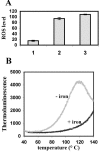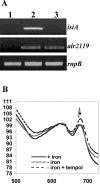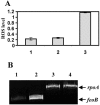Iron starvation leads to oxidative stress in Anabaena sp. strain PCC 7120
- PMID: 16159797
- PMCID: PMC1236655
- DOI: 10.1128/JB.187.18.6596-6598.2005
Iron starvation leads to oxidative stress in Anabaena sp. strain PCC 7120
Abstract
We establish here that iron deficiency causes oxidative stress in the cyanobacterium Anabaena sp. strain PCC 7120. Iron starvation leads to a significant increase in reactive oxygen species, whose effect can be abolished by treatment with the antioxidant tempol (4-hydroxy-2,2,6,6-tetramethylpiperidine 1-oxyl). Oxidative stress induced by iron starvation could be a common feature of photosynthetic bacteria.
Figures



Similar articles
-
Impairment of ntcA gene revealed its role in regulating iron homeostasis, ROS production and cellular phenotype under iron deficiency in cyanobacterium Anabaena sp. PCC 7120.World J Microbiol Biotechnol. 2017 Aug;33(8):158. doi: 10.1007/s11274-017-2323-5. Epub 2017 Jul 20. World J Microbiol Biotechnol. 2017. PMID: 28730560
-
pkn22 (alr2502) encoding a putative Ser/Thr kinase in the cyanobacterium Anabaena sp. PCC 7120 is induced by both iron starvation and oxidative stress and regulates the expression of isiA.FEBS Lett. 2003 Oct 9;553(1-2):179-82. doi: 10.1016/s0014-5793(03)01019-6. FEBS Lett. 2003. PMID: 14550569
-
NmtA, a novel metallothionein of Anabaena sp. strain PCC 7120 imparts protection against cadmium stress but not oxidative stress.Aquat Toxicol. 2018 Jun;199:152-161. doi: 10.1016/j.aquatox.2018.03.035. Epub 2018 Mar 30. Aquat Toxicol. 2018. PMID: 29626757
-
Zur (FurB) is a key factor in the control of the oxidative stress response in Anabaena sp. PCC 7120.Environ Microbiol. 2015 Jun;17(6):2006-17. doi: 10.1111/1462-2920.12628. Epub 2014 Oct 22. Environ Microbiol. 2015. PMID: 25244409
-
A large gene cluster encoding peptide synthetases and polyketide synthases is involved in production of siderophores and oxidative stress response in the cyanobacterium Anabaena sp. strain PCC 7120.Environ Microbiol. 2008 Oct;10(10):2574-85. doi: 10.1111/j.1462-2920.2008.01680.x. Epub 2008 Jun 28. Environ Microbiol. 2008. PMID: 18557768
Cited by
-
Elucidation of the coping strategy in an OMP homozygous knockout mutant of Synechocystis 6803 defective in iron uptake.Arch Microbiol. 2022 Jun 3;204(7):358. doi: 10.1007/s00203-022-02968-w. Arch Microbiol. 2022. PMID: 35657498
-
Mitochondrial-derived reactive oxygen species play a vital role in the salicylic acid signaling pathway in Arabidopsis thaliana.PLoS One. 2015 Mar 26;10(3):e0119853. doi: 10.1371/journal.pone.0119853. eCollection 2015. PLoS One. 2015. PMID: 25811367 Free PMC article.
-
TonB-dependent transporters and their occurrence in cyanobacteria.BMC Biol. 2009 Oct 12;7:68. doi: 10.1186/1741-7007-7-68. BMC Biol. 2009. PMID: 19821963 Free PMC article.
-
Light-induced energy dissipation in iron-starved cyanobacteria: roles of OCP and IsiA proteins.Plant Cell. 2007 Feb;19(2):656-72. doi: 10.1105/tpc.106.045351. Epub 2007 Feb 16. Plant Cell. 2007. PMID: 17307930 Free PMC article.
-
Epizoic communities of prokaryotes on healthy and diseased scleractinian corals in Lingayen Gulf, Philippines.Microb Ecol. 2009 Jan;57(1):117-28. doi: 10.1007/s00248-008-9400-0. Epub 2008 Jun 6. Microb Ecol. 2009. PMID: 18535850
References
-
- Cuzzocrea, S., M. C. McDonald, E. Mazzon, D. Siriwardena, G. Costantino, F. Fulia, G. Cucinotta, E. Gitto, S. Cordaro, I. Barberi, A. De Sarro, A. P. Caputi, and C. Thiemermann. 2000. Effects of tempol, a membrane-permeable radical scavenger, in a gerbil model of brain injury. Brain Res. 875:96-106. - PubMed
-
- Ferreira, F., and N. A. Straus. 1994. Iron deprivation. J. Appl. Phycol. 6:199-210.
-
- Havaux, M. 2003. Spontaneous and thermoinduced photon emission: new methods to detect and quantify oxidative stress in plants. Trends Plant Sci. 8:409-413. - PubMed
-
- Jang, H. H., K. O. Lee, Y. H. Chi, B. G. Jung, S. K. Park, J. H. Park, J. R. Lee, S. S. Lee, J. C. Moon, J. W. Yun, Y. O. Choi, W. Y. Kim, J. S. Kang, G. W. Cheong, D. J. Yun, S. G. Rhee, M. J. Cho, and S. Y. Lee. 2004. Two enzymes in one; two yeast peroxiredoxins display oxidative stress-dependent switching from a peroxidase to a molecular chaperone function. Cell 117:625-635. - PubMed
Publication types
MeSH terms
Substances
LinkOut - more resources
Full Text Sources

